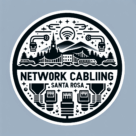Which RJ45 Color Code Is More Common? A Complete Guide
If you’re working with Ethernet cables or setting up a network, you’ve probably noticed the colored wires inside RJ45 connectors. But which RJ45 color code is more common, and why does it matter? Understanding these standards is essential for proper cabling, consistent performance, and easier troubleshooting. Our team of structured cabling experts in Santa Rosa ensures every RJ45 connection meets professional wiring standards for reliability and performance.
What Is an RJ45 Connector?
An RJ45 connector is the standard plug used for Ethernet cables. Inside each cable, there are eight individual wires, each with a specific color. How these wires are arranged — known as the color code or pinout — determines how data flows across the network.
Using the correct color code ensures:
- Reliable network communication
- Compatibility between devices
- Easier maintenance and troubleshooting
The Two Main RJ45 Color Codes
There are two primary wiring standards for RJ45 connectors, both defined by the TIA/EIA-568 standard:
- T568A
- T568B
Both standards use the same eight wires but arrange the colors differently.
T568A Color Order
- White/Green
- Green
- White/Orange
- Blue
- White/Blue
- Orange
- White/Brown
- Brown
T568B Color Order
- White/Orange
- Orange
- White/Green
- Blue
- White/Blue
- Green
- White/Brown
- Brown
While both standards work perfectly for Ethernet connections, T568B is more commonly used in the United States, especially for commercial installations.
Why T568B Is More Common
There are several reasons T568B is widely used:
- It matches older AT&T installations, which became a standard in many office buildings.
- Contractors and network professionals in the U.S. are more familiar with T568B.
- Many pre-terminated patch cables and network hardware come wired as T568B.
Despite T568B’s popularity, T568A is still widely used for residential applications and some government projects. The important thing is consistency — whichever standard you choose, stick with it throughout the network. Each RJ45 connector corresponds to a specific wiring structure — learn how many wires are in a network cable and how they’re arranged inside the connector.
Straight-Through vs. Crossover Cables
The RJ45 color code also affects cable type:
- Straight-through cable: Uses the same standard (T568A or T568B) on both ends. This is the most common type used to connect computers to switches, routers, or hubs.
- Crossover cable: Uses T568A on one end and T568B on the other. This type is used for connecting two similar devices directly, like PC to PC or switch to switch.
For most home and business networks today, straight-through cables with T568B wiring are the norm.
Tips for Working with RJ45 Color Codes
- Always test your cables with a network tester to ensure proper connectivity.
- Label cables and patch panels to avoid confusion in larger installations.
- Follow local and industry standards for wiring, especially in commercial buildings.
- Stay consistent — never mix T568A and T568B in the same network segment unless intentionally creating a crossover.
Conclusion
If you’re asking “Which RJ45 color code is more common?”, the answer is T568B, especially in the U.S. commercial and office networks. That said, T568A is still used in residential setups and certain government installations. The key takeaway is to maintain consistency and follow proper wiring standards to ensure reliable network performance. If you’re curious about mixing standards, find out whether you can use different RJ45 color codes and what happens when you do.
By understanding RJ45 color codes and using them correctly, you can prevent connectivity issues, simplify troubleshooting, and build a network that lasts for years.
